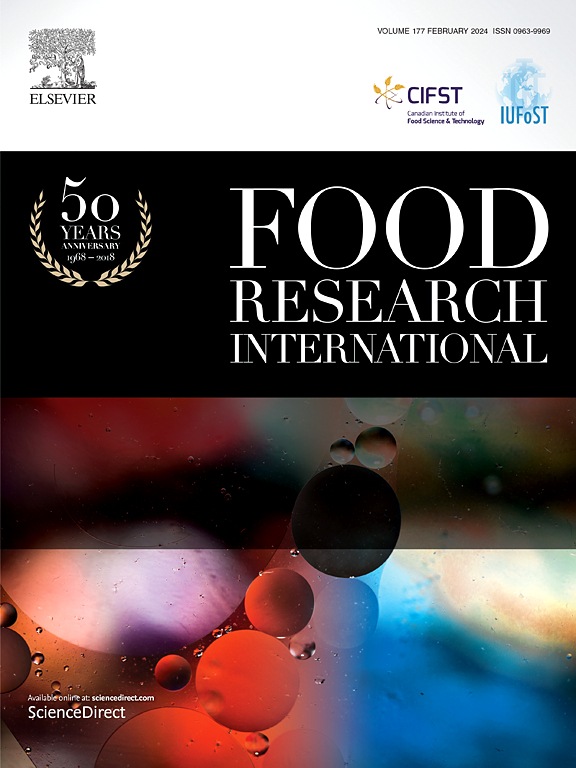无梗五加可食部位酚类化合物和三萜皂苷的UPLC-MS及多变量分析
IF 8
1区 农林科学
Q1 FOOD SCIENCE & TECHNOLOGY
引用次数: 0
摘要
无梗五加属五加科,可作药材和膳食补充剂,可作调味蔬菜、沙拉、泡菜、功能茶、酒等食用。它们的可食用部分(芽、叶、果和茎)被认为是一种非常有价值的食物来源,对健康有益。对这些植物部位中功能化合物的定性和定量特征的比较仍然有限。本研究利用超高效液相色谱-质谱和多变量分析方法,对其芽、叶、果和茎中的酚类化合物和三萜皂苷进行了表征。共鉴定了116个化合物,其中36个为首次从棘五加属中分离得到。比较了chiisano苷、槲皮素3-O-glucuronide等19个目标化合物的含量,并通过PLS-DA分析鉴定了57个化学标记物。3,4-二倍羽扇烷型皂苷主要存在于茎和叶中,齐墩烷型皂苷主要存在于茎和果实中。木脂素在茎中被鉴定为化学标记,而阿魏酰奎宁酸衍生物和黄酮类化合物(杉木素和花青素苷)在果实中被鉴定为特异性标记。这些发现为了解该物种的植物化学特征提供了有价值的信息,可用于功能食品的开发、与其他植物的快速区分以及相关领域的应用。本文章由计算机程序翻译,如有差异,请以英文原文为准。

Comparative analysis of phenolic compounds and triterpenoid saponins in edible plant parts of Acanthopanax sessilflorus using UPLC-MS and multivariate analyses
Acanthopanax sessiliflorus, belonging to the Araliaceae family, is used as medicinal herbs and dietary supplements, and can be consumed as seasoned vegetables, salads, pickles, functional tea, and wine. Their edible parts (shoots, leaves, fruis, and stems) are considered as a highly valuable food source with health benefits. The comparison of the qualitative and quantitative characteristics of functional compounds in these plant parts is still limited. This study characterized phenolic compounds and triterpenoid saponins in the shoots, leaves, fruits, and stems using UPLC-MS and multivariate analyses. 116 compounds were investigated, with 36 compounds reported for the first time in the Acanthopanax genus. The contents of 19 target compounds including chiisanoside and quercetin 3-O-glucuronide were compared, and 57 chemical markers were identified through PLS-DA analysis. 3,4-Seco-lupane-type saponins were mainly found in the shoots and leaves, whereas oleanane-type saponins were mainly present in the stems and fruits. Lignans were identified as chemical markers in the stems, while feruloylquinic acid derivatives and flavonoids (taxifolin and cyanidin glycosides) were distinctively found in the fruits. These findings provide valuable insight into phytochemical profile of the species, which may be utilized in functional food development, rapid differentiation from other plants, and applications in related fields.
求助全文
通过发布文献求助,成功后即可免费获取论文全文。
去求助
来源期刊

Food Research International
工程技术-食品科技
CiteScore
12.50
自引率
7.40%
发文量
1183
审稿时长
79 days
期刊介绍:
Food Research International serves as a rapid dissemination platform for significant and impactful research in food science, technology, engineering, and nutrition. The journal focuses on publishing novel, high-quality, and high-impact review papers, original research papers, and letters to the editors across various disciplines in the science and technology of food. Additionally, it follows a policy of publishing special issues on topical and emergent subjects in food research or related areas. Selected, peer-reviewed papers from scientific meetings, workshops, and conferences on the science, technology, and engineering of foods are also featured in special issues.
 求助内容:
求助内容: 应助结果提醒方式:
应助结果提醒方式:


